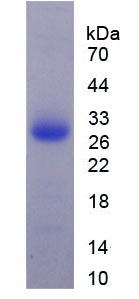Active Complement Component 1, Q Subcomponent A (C1qA) 

Complement Component 1,q Subcomponent,Alpha Polypeptide
- UOM
- FOB US$ 259.00 US$ 648.00 US$ 1,296.00 US$ 3,888.00 US$ 9,720.00
- Quantity
Overview
Properties
- Product No.APD207Hu01
- Organism SpeciesHomo sapiens (Human) Same name, Different species.
- ApplicationsCell culture; Activity Assays.
Research use only - DownloadInstruction Manual
- CategoryImmune molecule
- Buffer Formulation20mM Tris, 150mM NaCl, pH8.0, containing 1mM EDTA, 1mM DTT, 0.01% SKL, 5% Trehalose and Proclin300.
- Traits Freeze-dried powder, Purity > 95%
- Isoelectric Point9.6
Sign into your account
Share a new citation as an author
Upload your experimental result
Review

Contact us
Please fill in the blank.
Activity test

Figure. The binding activity of C1qA with CRP.
The complement component 1q (C1q) is composed of 18 polypeptide chains: six A-chains, six B-chains, and six C-chains. Complement Component 1, Q Subcomponent A (C1qA) is six A-chains of C1q. Complement component 1q (C1q is a protein complex involved in the complement system, which is part of the innate immune system. C1q together with C1r and C1s form the C1 complex. It is potentially multivalent for attachment to the complement fixation sites of immunoglobulin. The sites are on the CH2 domain of IgG and, it is thought, on the CH4 domain of IgM. IgG4 cannot bind C1q, but the other three IgG types can. Besides, C Reactive Protein (CRP) has been identified as an interactor of C1qA, thus a binding ELISA assay was conducted to detect the interaction of recombinant human C1qA and recombinant human CRP. Briefly, C1qA were diluted serially in PBS, with 0.01% BSA (pH 7.4). Duplicate samples of 100μL were then transferred to CRP-coated microtiter wells and incubated for 2h at 37℃. Wells were washed with PBST and incubated for 1h with anti-C1qA pAb, then aspirated and washed 3 times. After incubation with HRP labelled secondary antibody, wells were aspirated and washed 3 times. With the addition of substrate solution, wells were incubated 15-25 minutes at 37℃. Finally, add 50µL stop solution to the wells and read at 450nm immediately. The binding activity of C1qA and CRP was shown in Figure 1, and this effect was in a dose dependent manner.
Usage
Reconstitute in 20mM Tris, 150mM NaCl (pH8.0) to a concentration of 0.1-1.0 mg/mL. Do not vortex.
Storage
Avoid repeated freeze/thaw cycles. Store at 2-8°C for one month. Aliquot and store at -80°C for 12 months.
Stability
The thermal stability is described by the loss rate. The loss rate was determined by accelerated thermal degradation test, that is, incubate the protein at 37°C for 48h, and no obvious degradation and precipitation were observed. The loss rate is less than 5% within the expiration date under appropriate storage condition.
Increment services
-
 BCA Protein Quantification Kit
BCA Protein Quantification Kit
-
 Molecular Mass Marker for Protein
Molecular Mass Marker for Protein
-
 Monoclonal Antibody Customized Service
Monoclonal Antibody Customized Service
-
 Polyclonal Antibody Customized Service
Polyclonal Antibody Customized Service
-
 Protein Activity Test Experiment Service
Protein Activity Test Experiment Service
-
 Electrophoretic Mobility Shift Assay (EMSA) Experiment Service
Electrophoretic Mobility Shift Assay (EMSA) Experiment Service
-
 Buffer
Buffer
-
 Lentivirus Packaging Experiment Service
Lentivirus Packaging Experiment Service
-
 Adenovirus Packaging Experiment Service
Adenovirus Packaging Experiment Service
-
 Real Time PCR Experimental Service
Real Time PCR Experimental Service
-
 Spike RBD Protein (S-RBD)
Spike RBD Protein (S-RBD)
-
 Protein G
Protein G
-
 Protein A
Protein A
Citations
- LCN2 is a new diagnostic biomarker and potential therapeutic target in idiopathic short staturePubmed:35610759
- Competitive inhibition of the classical complement pathway using exogenous single-chain C1q recognition proteinsPubmed:35690144









